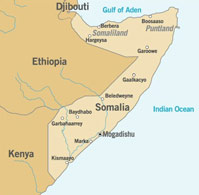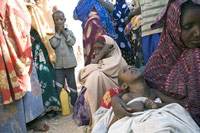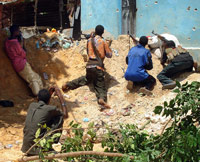Somalia: the third 'theatre' in Washington's war on terror

History is being repeated in Somalia where the worst fighting in 15 years recently erupted causing a massive humanitarian crisis. Yet again, the US plays a central role and UN is inept in resolving the conflict.
By Malachy Browne
The invasion of Somalia by US-backed Ethiopian troops has plunged the East African state into violence not seen since the country's disintegration following the deposition of dictator Siad Barre by warlords in 1991. Over 5,000 Somalis have been killed or wounded this year, and over 400,000 people have been internally displaced since February – a displacement rate worse than Iraq. Once again, disease and famine loom as the humanitarian crisis worsens: food prices have soared and medical supplies are confined to the black market as the delivery of aid is hampered by distribution problems.
The invasion came several months after the Union of Islamic Courts (ICU) seized Mogadishu in June 2006 from warlords armed by the US . The pretext for the invasion was support for the Transitional Federal Government (TFG) which was established in Kenya in 2004 following internationally supported peace talks and whose authority faced a challenge from the newly instated ICU. Despite two years of governance, the TFG failed to establish itself in violence-riven Mogadishu, instead operating from Baidoa nearer the Ethiopian border.
The ICU's dominance in Mogadishu, however, brought peace and security not seen in 15 years. The seaport and airport were opened for the first time in years allowing much needed aid to be delivered, which the ICU distributed beyond the capital. The ICU established nascent institutions of governance and brought order where chaos prevailed – a record that contrasted starkly with the internationally “legitimised” TFG who failed to win support outside Baidoa.
However, the success of the ICU fuelled American and Ethiopian anxieties over the prospect of a nationalist Islamic state in the region – this, coupled with a suspected al Qaeda presence in Somalia, provided the real impetus for their joint intervention.
The ICU's popularity among Somalis is drawn from the restoration of security on the streets of Mogadishu through the implementation of a system of Islamic courts. The system has enjoyed a decade of support in its stronghold of northern Mogadishu, but as clan rivalry continued to ravage other parts of the capital and surrounding areas, the appeal of the ICU spread.
The ICU found additional support at an ideological level by its endorsement of the two characteristics that pervade Somalia's clan-based culture – Islam and national unity. The vast majority of Somalis practice Islam, and many support the objective of national unity that was enshrined in the constitution upon independence in 1960.
 Somalia was divided into five separate territories during 19th century colonisation which have yet to be reunited – a goal symbolized by the five-pointed white star on the Somali national flag. One such region, the Ogadan plateau where many Somalis reside, was annexed in the late 1800s by present day Ethiopia, a Christian state and historic adversary of Somalia.
Somalia was divided into five separate territories during 19th century colonisation which have yet to be reunited – a goal symbolized by the five-pointed white star on the Somali national flag. One such region, the Ogadan plateau where many Somalis reside, was annexed in the late 1800s by present day Ethiopia, a Christian state and historic adversary of Somalia.
Widespread endorsement of the ICU by Somalis raised Ethiopian fears that there would be a “radicalisation of Ethiopia's Muslim community” and a resurgence of the Ogadan National Liberation Front, a group seeking the secession of the Ogaden region from Southern Ethiopia.
A general lack of transparency in the ICU and disunity between ICU moderates and extremists who voice differing policy views exacerbated Ethiopian and American concerns about a prospective Islamic state. So too, the imposition of Sharia law by the ICU in Somalia is anathema to Western and Christian values and is the reason cited by some Somali for fleeing areas under ICU control.
The US proposed a draft UN Security Council (UNSC) resolution, which was subsequently approved in December, to lift the arms embargo imposed on Somalia in 1992, effectively endorsing the Ethiopian invasion. Ethiopian troops entered Baidoa in late December 2006 to support the TFG force as tensions grew between the TFG and ICU. The ICU warned the Ethiopian “occupiers” to withdraw, and declared jihad on Ethiopia when they refused to do so, attacking TFG and Ethiopian forces near Baidoa.
The disjointed and deficient ICU force was swiftly defeated by the TFG and Ethiopian force. However, Ethiopia and the US were intent on destroying all remnants of the ICU, and the militants were pursued first to Mogadishu, then to southern Somalia where further fighting ensued. The US navy was deployed to the Somali coast to capture fleeing ICU fighters and the TFG later signed a two year, $50m deal with private US marine security company to carry out coastal patrols. In January, US MIG fighter jets bombed a densely forested region of southern Somalia at Ethiopia's behest where ICU forces were believed to have sought refuge. At least 19 people were killed and subsistence farming destroyed. In familiar parlance, a Whitehouse spokesperson said the attacks were a reminder that there is no safe haven for Islamic militants.
In response to the actions of both countries, independent watchdog Chatham House concluded: “In an uncomfortably familiar pattern, the general multilateral concern to support the reconstruction and rehabilitation of Somalia has been hijacked by unilateral actors, especially Ethiopia and the United States”.
American agenda
The introduction of Somalia as the third “theatre” in Washington's war on terror was inevitable. The US believes that certain clans in anarchic Somalia harbour three suspects in the 1998 bombings of US embassies in Kenya and Tanzania in which 250 people died – Fazul Abdullah Mohamed (from the Comoros Islands); Abu Talha al-Sudani (a Sudanese) and Saleh Ali Saleh Nabhan (a Kenyan). The Pentagon also says that direct links exist between the ICU and al Qaeda, a belief reflected in repeated references to the ICU members as “terrorists” and “insurgents”.
Although there has been no confirmed sighting of the three bombing suspects in Somalia, independent experts believe that Mohamed may possibly reside there but reject direct links between Mohammed and the ICU. The ICU flatly rejects claims that it is linked with al Qaeda, as do analysts who believe that although al Qaeda may have a presence in Somalia, any direct link between the ICU and al Qaeda is tenuous and unproven.
Washington has repeatedly flouted international sanctions in order to fulfil its objectives in Somalia. In persistent attempts to flush out these and other suspected “terrorists” and to undermine the increasing popularity of the ICU, the US has breached the 1992 UN arms embargo by strategically arming Somali warlords opposed to the ICU.
A mere three months after Washington pressed the UN to impose sanctions on North Korea, it knowingly allowed Ethiopia to complete a purchase of weapons from North Korea that would reinforce the occupation of Somalia, again bending international sanctions to meet its foreign policy objectives. After the New York Times broke the story in April, a Whitehouse spokesperson said that the while US had decided not to block this particular arms purchase, it would “press” Ethiopia not to make further purchases.
In addition to supporting warlords, US operatives in Mogadishu are believed to be responsible for the many unexplained disappearances and assassinations of prominent ICU members. The targets, according to a report by Chatham House, are men “not with religious backgrounds, [but the] driving force behind the implementation of court jurisdiction” that brought stability to Mogadishu and beyond.
As the ICU's influence began to spread in 2006, a group of rival warlords, supported by the US, formed the deceptively entitled ‘Alliance for Restoration of Peace and Counter Terrorism' to oppose the ICU. Contrary to the what the title of the rival alliance suggests, Chatham House said that the ICU had a “proven track record in restoring security and was associated with the provision of other social services and charitable works”. And according to Harun Hassan of Open Democracy, an expert on Somali affairs, this was the first reference to Islamic terrorism organised within Somalia, and the language used suspiciously echoes the parlance of American foreign policy.
Meanwhile, with 75 per cent of Americans disapproving of the US campaign in Iraq, media reportage of the Somali crisis is negligible in the US. A study of the evening newscasts of three prominent American television networks – ABC, NBC, and CBS – from February to April showed that the war in Somalia was mentioned merely once. Three sentences were dedicated to the story on a Sunday night broadcast.
Humanitarian crisis
Reports from Mogadishu are harrowing. Aid workers estimate that 1,300 Somalis were killed and 4,300 were wounded in fighting from December to April. To date, an estimated 600 people have died from cholera and acute diarrhoea. Four days of heavy fighting at the end of March killed 400 civilians, with many women and children among the dead, as population centres were indiscriminately fired upon by Ethiopian tanks – residential areas, a market, a hospital and an Internally Displaced Person (IDP) settlement were hit. A lull in fighting in early April allowed people to pull several hundred dead bodies from the streets.
Amnesty International (AI) has pleaded with Ethiopian troops “to apply the principles of distinction and proportionality, and take the precautions required by international humanitarian law” when retaliating to militia attacks launched from population centres.
 The United Nations estimates that since February, over 400,000 people fled Mogadishu between the outbreaks of violence. Most IDPs are living in “flimsy shelters made of fabric wrapped around sticks” and many more who have not been provided with plastic sheeting are exposed to heavy rain at night. Many among the 40,000 IDPs who fled in March to Afogee, 30km from Mogadishu, are living under trees completely exposed to the elements.
The United Nations estimates that since February, over 400,000 people fled Mogadishu between the outbreaks of violence. Most IDPs are living in “flimsy shelters made of fabric wrapped around sticks” and many more who have not been provided with plastic sheeting are exposed to heavy rain at night. Many among the 40,000 IDPs who fled in March to Afogee, 30km from Mogadishu, are living under trees completely exposed to the elements.
A further 2,000 newly displaced people, mostly women and children, recently joined the several thousand IDPs already camped near the Kenyan border which was closed by Kenya in January due to “security concerns”. The closure of the border makes the delivery of aid particularly difficult. AI says that the refugees are now in “desperate need of humanitarian assistance” and accuses Kenya of breaching international refugee protection law. Kenya has also been criticised for colluding with the US and Ethopia in transporting Somali refugees captured near the border to secret detention camps where they have been held incommunicado and without legal representation.
Host communities already beyond capacity are equally as needy as IDPs, and the UN fears that the present crisis will worsen. The UN's Refugee Agency has almost doubled its initial budget from $5.7m to $10m for its humanitarian response in 2007-2008 but the pressure on host communities and the relief effort will increase dramatically. The TFG is expelling people from public buildings in which a further 250,000 people had sheltered. Many of these have no homes to return to and will be forced to join the overcrowded IDP camps.
Although fighting in Mogadishu has ceased in the past two weeks, and fewer people are now leaving the city, less than one per cent of displaced Somalis have yet returned to the capital. Many IDPs have no homes to return to, others cannot afford transport to Mogadishu, but the vast majority fear that fighting in the capital will resume - TFG and Ethiopian troops still patrol the streets and the situation remains very tense.
UN ineptitude
The UNSC has thus far failed to make an intervention of consequence in the conflict. A handful of condemnations and a plea by the newly appointed Secretary General, Ban Ki Moon, “to embark on a dialogue with all Somali parties” have been disregarded by the TFG and Ethiopia. A resolution passed by the UNSC in February to send a mission of 8,000 African Union (AU) forces to Somalia (Amisom) has delivered merely 1,400 Ugandan troops to date.
UN actions, and Amisom in particular, are viewed by the ICU and other disaffected clans as partisan. The “partial” lifting of the arms embargo in December effectively endorsed the Ethiopian invasion. The mandate given to Amisom by the UN in February was to protect only the TFG, not the wider Somali citizenry.
Ethiopian withdrawal is key to resolving the current impasse – their presence is the root cause of the resistance and is unsustainable. Having reneged on earlier commitments to withdraw, Ethiopia now refuses to do so until half of the Amisom force is deployed.
Last week, Amisom requested NATO to forecast its availability to air-lift troops into Somalia in similar fashion to the AU mission to Sudan. But the ICU and other disaffected militia, who view Amisom as another partisan force, say that it will fight Amisom forces. An Amisom aircraft that crashed in March killing 11 people is thought to have been shot down, and four Ugandan soldiers were killed in a roadside bomb last month.
 The TFG, dominated by the Darod clan, is not trusted by many Somalis; partly as a result of its relationship with Ethiopia, but also because of its unwillingness to reconcile with armed opponents. President Abdullahi Yusuf Ahmed has insisted on Hawiye and ICU disarmament as a precondition to their involvement in peace negotiations due to take place on 14 June. Ahmed, himself a Darod, is suspected of using the conflict to exact revenge upon historic rivals, the Hawiye, who refuse to disarm. Aside from clan complexities, Somali reunification is further complicated by the autonomous northern regions of Puntland and Somaliland who have distanced themselves from the TFG and violence of the south.
The TFG, dominated by the Darod clan, is not trusted by many Somalis; partly as a result of its relationship with Ethiopia, but also because of its unwillingness to reconcile with armed opponents. President Abdullahi Yusuf Ahmed has insisted on Hawiye and ICU disarmament as a precondition to their involvement in peace negotiations due to take place on 14 June. Ahmed, himself a Darod, is suspected of using the conflict to exact revenge upon historic rivals, the Hawiye, who refuse to disarm. Aside from clan complexities, Somali reunification is further complicated by the autonomous northern regions of Puntland and Somaliland who have distanced themselves from the TFG and violence of the south.
Reconciliation in the short-term is not a prospect, but June's conference presents an opportunity to set talks in motion. The immediate focus must be upon the cessation of hostilities and safe humanitarian access. The UN should redirect Amisom with a clear mandate to protect all Somali citizens and facilitate the relief effort. Washington can restore some credibility in Africa by demonstrating impartial leadership to press and incentivise the TFG to include its adversaries in a settlement.
Stick and carrot mediation will focus parties on their objectives, but sustaining dialogue is vital. Only through dialogue can the current impasse be resolved and the parties reconciled.
